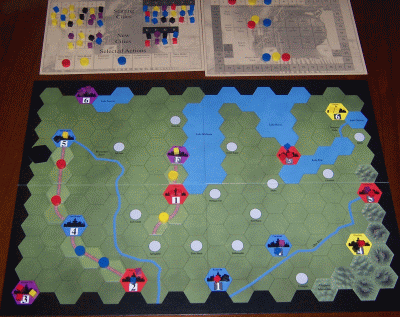Manufacturer: Warfrog / Winsome Games
Author: Martin Wallace
Number of Players: 3-6
Age: 13 years plus
Time: 120-180 mins.
Year: 2002
ENGLISH MAIN PAGE
 Deutsche Spielerezension
Deutsche Spielerezension
| Age of Steam |
| General Information: Manufacturer: Warfrog / Winsome Games Author: Martin Wallace Number of Players: 3-6 Age: 13 years plus Time: 120-180 mins. Year: 2002 ENGLISH MAIN PAGE  Deutsche Spielerezension Deutsche Spielerezension |
 |
| Game Components: 1 Gameboard - 1 Goods/Actions Display Card - 1 Income Display Card - 8 Town Discs - 136 Hexagonal Track Tiles - 8 Hexagonal New City Tiles - 96 Goods Cubes - 6 Sets of Track Ownership Discs - 40 Gold counters - 40 Small Silver Counters - 10 Large Silver Counters - 1 Turn Track Marker - 6 Dice - 1 Rulebook |
| Further Information: - Homepage of Warfrog |
| Troudi says 9 of
10 points: "Age of Steam" is a great game. It is not a game just for railway enthusiasts like so many others (e.g. British Rails) but a game for players who enjoy complex games and especially complex business management simulations. "Age of Steam" is not an easy game - the rules are easy to understand and easy to learn and explain but you do not really know what the game is really about when playing it for the first time. The most common problem all beginners have is spending all the money and earning nothing. And that is the point: The art of investing one's money to get the largest benefit possible. Never worry: It is not unusual if you spend more money than you get in the first two or three turns of the game! And that exactly is what makes the game really interesting. You never know who the winner of the game is after you get to the last 2 turns. The game is not very suitable for families and not very suitable for players who expect an easy railroad game. The game is most suitable for players who like strategic and commercial games and who enjoy detailed planning. My advice: If you like such games do not hesitate to buy "Age of Steam"; if you are not sure whether you will like a game like this - at least test it! "Age of Steam" is a great game that should not be amiss in any good game collection. |